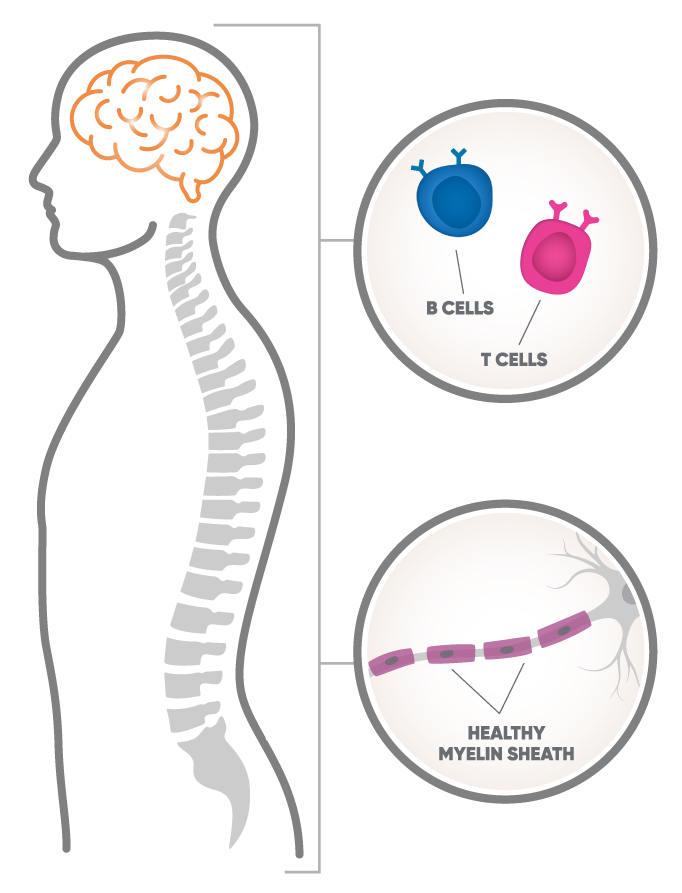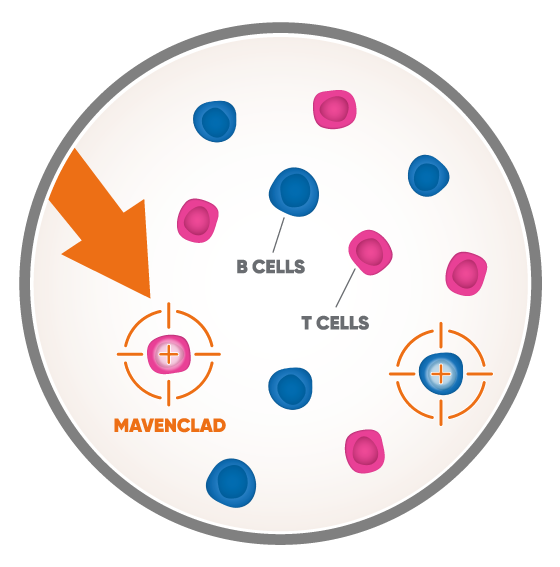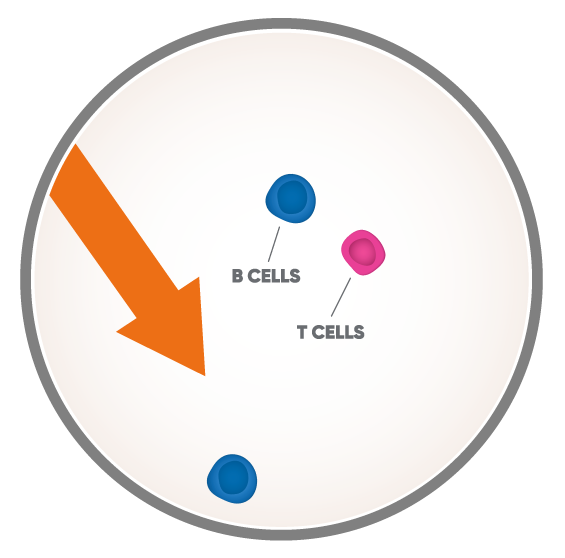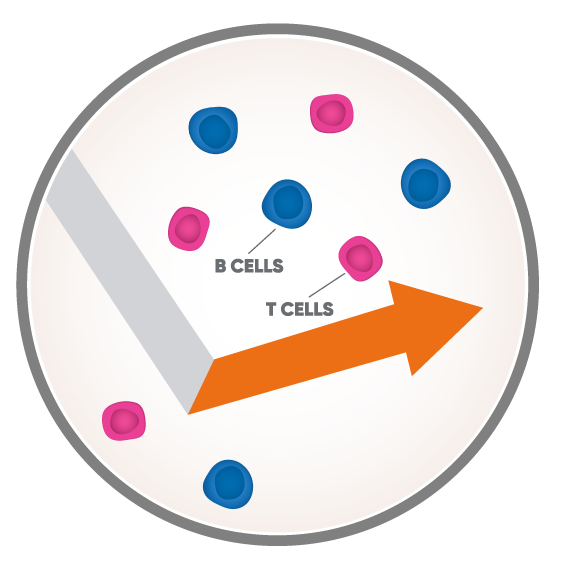
WHAT IS
MAVENCLAD?
MAVENCLAD is the first and only short-course oral treatment for relapsing multiple sclerosis (RMS) with no more than 10 treatment days a year for 2 years.*
*Your healthcare provider will continue to monitor your health during the 2 yearly treatment courses, as well as between treatment courses and for at least another 2 years, during which you do not need to take MAVENCLAD. Your healthcare provider may delay or completely stop treatment with MAVENCLAD if you have severe side effects. It is not known if it is safe and effective for people to restart MAVENCLAD after the full 4-year period.
If you’ve had an inadequate response to, or are unable to tolerate, an alternate drug indicated for the treatment of MS, look to MAVENCLAD for a short-course treatment option with proven efficacy.
HOW MAVENCLAD MAY WORK
Your immune system and MS
Cells in your immune system work together to protect the body
Your immune system is made up of two different cell groups: innate immune cells, which is your body’s first line of defense, and adaptive immune cells (including B and T cells), the second line of defense, which plays a role in your body’s long-term immune response.
When your immune system is working properly, it defends your body against infection. When your immune system mistakenly attacks normal, healthy cells, it’s considered an autoimmune condition, which is what multiple sclerosis is thought to be.

In MS, the immune system mistakenly attacks the central nervous system, affecting the brain, spinal cord, and optic nerve
When you have MS, B and T cells recognize your normal, healthy tissues of the central nervous system as foreign. When this happens, the immune system (including B and T cells) attacks the myelin sheath, the insulating layer that protects nerve fibers in the central nervous system. The damage from these attacks causes inflammation and interrupts the communication signals between nerves, which shows up as lesions and MS-related symptoms.

Your immune system and MAVENCLAD
MAVENCLAD targets and reduces the B and T cells that contribute to MS attacks
MAVENCLAD temporarily reduces the number of B and T cells circulating in the body. This means there are fewer such cells attacking the nerves of the central nervous system. Even when the body has a reduced number of these cells, other immune cells, including innate cells, are still present to defend the body from infection. However, MAVENCLAD can lower adaptive cell counts which may increase the likelihood of infections during treatment.

MAVENCLAD targets and reduces the B and T cells that contribute to MS attacks

Even when B and T cell counts are reduced, other immune cells are still present to defend the body from infections
Over time, new B and T cells recover
MAVENCLAD is taken for up to 10 days each year for 2 years. After each treatment course and over several months, new B and T cell counts recover to near normal (although they may not go back to pre-treatment levels). Your healthcare provider will monitor your health and blood cell count and make adjustments if necessary.

While MAVENCLAD will continue to treat your relapsing MS over the 2 treatment years—even when you’re not actively taking it—MAVENCLAD does not continuously suppress the immune system but reduces certain immune cells involved in MS. Shortly after each cycle of MAVENCLAD, these cells begin to increase again.
MAVENCLAD IS NOT like the other form of cladribine (used to treat cancer, such as hairy cell leukemia)
MAVENCLAD was specifically made—and studied in clinical trials—for patients with MS.
There are a number of key differences between MAVENCLAD and other forms of cladribine. Cladribine has been analyzed in multiple formations and disease states. MAVENCLAD is a specific dose, administered orally, that has been studied specifically for MS.
MAVENCLAD is not an infusion form of cladribine currently being used to treat hairy cell leukemia.
Important Safety Information
- Risk of cancer (malignancies). You should follow healthcare provider instructions about screening for cancer.
- MAVENCLAD may cause birth defects if used during pregnancy. Women must not be pregnant when they start treatment with MAVENCLAD or become pregnant during MAVENCLAD dosing and within 6 months after the last dose of each yearly treatment course. You should stop treatment with MAVENCLAD and contact your healthcare provider right away if you become pregnant during treatment with MAVENCLAD.
- For women who are able to become pregnant:
- Your healthcare provider should order a pregnancy test before you begin your first and second yearly treatment course of MAVENCLAD to make sure that you are not pregnant.
- Ask your healthcare provider which contraceptive method is right for you. Women and men being treated with MAVENCLAD should use effective birth control (contraception) on the days on which they take MAVENCLAD and for at least 6 months after the last dose of each yearly treatment course.
- For women who are able to become pregnant:
- have cancer (malignancy).
- are pregnant, plan to become pregnant, or are a woman of childbearing age or a man able to father a child and you are not using birth control.
- are breastfeeding.
- are human immunodeficiency virus (HIV) positive.
- have active infections, including tuberculosis (TB), hepatitis B or C.
- are allergic to cladribine.
- think you have an infection.
- have taken, take, or plan to take medicines that affect your immune system or blood cells, or other treatments for MS. Certain medicines can increase your risk of getting an infection.
- have had a recent vaccination or are scheduled to receive any vaccinations. You should not receive live or live-attenuated vaccines within the 4 to 6 weeks preceding treatment with MAVENCLAD or receive these types of vaccines during your treatment with MAVENCLAD and unless directed by your healthcare provider.
- have heart failure.
- have or have had cancer.
- have liver or kidney problems.
- are breastfeeding or plan to breastfeed. It is not known if MAVENCLAD passes into your breast milk. Do not breastfeed on the days on which you take MAVENCLAD, and for 10 days after the last dose.
- MAVENCLAD is given as two yearly treatment courses, consisting of 2 treatment weeks (cycles) about a month apart.
- Handle MAVENCLAD with dry hands and take immediately after opening the blister pack. Take with water and do not chew the tablet. MAVENCLAD can be taken with or without food and should be taken at least 3 hours apart from other medicines.
- Wash your hands after handling MAVENCLAD. Limit contact with your skin (especially on your face). Wash skin and surfaces with water if contact occurs.
- If you miss a dose, take it as soon as you remember on the same day. If the whole day passes before you remember, take your missed dose the next day. Do not take 2 doses at the same time. Instead, you will extend the number of days in that treatment week.
Your healthcare provider will continue to monitor your health during the 2 yearly treatment courses, and for at least another 2 years during which you do not need to take MAVENCLAD. It is not known if MAVENCLAD is safe and effective in people who restart MAVENCLAD treatment more than 2 years after completing 2 yearly treatment courses.
- low blood cell counts have happened and can increase your risk of infections during treatment with MAVENCLAD. Blood tests are needed before you start treatment with MAVENCLAD, during your treatment with MAVENCLAD, and afterward, as needed.
- serious infections such as:
- life-threatening or fatal infections caused by bacteria, viruses, parasites or fungi.
- TB, hepatitis B or C, and shingles (herpes zoster). Fatal cases of TB and hepatitis have happened with cladribine during clinical studies. Tell your healthcare provider right away if you get any symptoms of the following infection related problems or if any of the symptoms get worse, including fever, aching painful muscles, headache, feeling of being generally unwell, loss of appetite, burning, tingling, numbness or itchiness of the skin in the affected area, skin blotches, blistered rash, or severe pain.
- progressive multifocal leukoencephalopathy (PML). PML is a rare brain infection that usually leads to death or severe disability. Although PML has not been seen in MS patients taking MAVENCLAD, it may happen in people with weakened immune systems. Tell your healthcare provider right away if you have any new or worsening neurologic signs or symptoms. These may include: weakness on 1 side of your body, loss of coordination in your arms and legs, decreased strength, problems with balance, changes in your vision, changes in your thinking or memory, confusion, or changes in your personality.
- liver problems. Blood tests should be performed to check your liver before you start taking MAVENCLAD. Symptoms of liver problems may include: nausea, vomiting, stomach pain, tiredness, loss of appetite, dark urine, or your skin or the whites of your eyes turn yellow.
- allergic reactions (hypersensitivities). You should stop treatment and seek immediate medical attention if any signs or symptoms of allergic reactions occur. Symptoms of an allergic reaction may include skin rash, swelling or itching of the face, lips, tongue or throat, or trouble breathing.
- heart failure. MAVENCLAD may cause heart failure, which means your heart may not pump as well as it should. Call your healthcare provider or go to the closest emergency room for medical help right away if you have any signs or symptoms such as shortness of breath, a fast or irregular heart beat, or unusual swelling in your body.
The most common side effects of MAVENCLAD include: upper respiratory infection, headache, and low white blood cell counts.
These are not all the possible side effects of MAVENCLAD. Call your doctor for medical advice about side effects. To report SUSPECTED ADVERSE REACTIONS, contact EMD Serono at: 1-800-283-8088 ext. 5563 or FDA at 1-800-FDA-1088 or www.fda.gov/medwatch.
Please see full Prescribing Information/Medication Guide, including serious side effects, for additional Important Safety Information.
- Risk of cancer (malignancies). You should follow healthcare provider instructions about screening for cancer.
- MAVENCLAD may cause birth defects if used during pregnancy. Women must not be pregnant when they start treatment with MAVENCLAD or become pregnant during MAVENCLAD dosing and within 6 months after the last dose of each yearly treatment course. You should stop treatment with MAVENCLAD and contact your healthcare provider right away if you become pregnant during treatment with MAVENCLAD.
- For women who are able to become pregnant:
- Your healthcare provider should order a pregnancy test before you begin your first and second yearly treatment course of MAVENCLAD to make sure that you are not pregnant.
- Ask your healthcare provider which contraceptive method is right for you. Women and men being treated with MAVENCLAD should use effective birth control (contraception) on the days on which they take MAVENCLAD and for at least 6 months after the last dose of each yearly treatment course.
- For women who are able to become pregnant:
- have cancer (malignancy).
- are pregnant, plan to become pregnant, or are a woman of childbearing age or a man able to father a child and you are not using birth control.
- are breastfeeding.
- are human immunodeficiency virus (HIV) positive.
- have active infections, including tuberculosis (TB), hepatitis B or C.
- are allergic to cladribine.
- think you have an infection.
- have taken, take, or plan to take medicines that affect your immune system or blood cells, or other treatments for MS. Certain medicines can increase your risk of getting an infection.
- have had a recent vaccination or are scheduled to receive any vaccinations. You should not receive live or live-attenuated vaccines within the 4 to 6 weeks preceding treatment with MAVENCLAD or receive these types of vaccines during your treatment with MAVENCLAD and unless directed by your healthcare provider.
- have heart failure.
- have or have had cancer.
- have liver or kidney problems.
- are breastfeeding or plan to breastfeed. It is not known if MAVENCLAD passes into your breast milk. Do not breastfeed on the days on which you take MAVENCLAD, and for 10 days after the last dose.
- MAVENCLAD is given as two yearly treatment courses, consisting of 2 treatment weeks (cycles) about a month apart.
- Handle MAVENCLAD with dry hands and take immediately after opening the blister pack. Take with water and do not chew the tablet. MAVENCLAD can be taken with or without food and should be taken at least 3 hours apart from other medicines.
- Wash your hands after handling MAVENCLAD. Limit contact with your skin (especially on your face). Wash skin and surfaces with water if contact occurs.
- If you miss a dose, take it as soon as you remember on the same day. If the whole day passes before you remember, take your missed dose the next day. Do not take 2 doses at the same time. Instead, you will extend the number of days in that treatment week.
Your healthcare provider will continue to monitor your health during the 2 yearly treatment courses, and for at least another 2 years during which you do not need to take MAVENCLAD. It is not known if MAVENCLAD is safe and effective in people who restart MAVENCLAD treatment more than 2 years after completing 2 yearly treatment courses.
- low blood cell counts have happened and can increase your risk of infections during treatment with MAVENCLAD. Blood tests are needed before you start treatment with MAVENCLAD, during your treatment with MAVENCLAD, and afterward, as needed.
- serious infections such as:
- life-threatening or fatal infections caused by bacteria, viruses, parasites or fungi.
- TB, hepatitis B or C, and shingles (herpes zoster). Fatal cases of TB and hepatitis have happened with cladribine during clinical studies. Tell your healthcare provider right away if you get any symptoms of the following infection related problems or if any of the symptoms get worse, including fever, aching painful muscles, headache, feeling of being generally unwell, loss of appetite, burning, tingling, numbness or itchiness of the skin in the affected area, skin blotches, blistered rash, or severe pain.
- progressive multifocal leukoencephalopathy (PML). PML is a rare brain infection that usually leads to death or severe disability. Although PML has not been seen in MS patients taking MAVENCLAD, it may happen in people with weakened immune systems. Tell your healthcare provider right away if you have any new or worsening neurologic signs or symptoms. These may include: weakness on 1 side of your body, loss of coordination in your arms and legs, decreased strength, problems with balance, changes in your vision, changes in your thinking or memory, confusion, or changes in your personality.
- liver problems. Blood tests should be performed to check your liver before you start taking MAVENCLAD. Symptoms of liver problems may include: nausea, vomiting, stomach pain, tiredness, loss of appetite, dark urine, or your skin or the whites of your eyes turn yellow.
- allergic reactions (hypersensitivities). You should stop treatment and seek immediate medical attention if any signs or symptoms of allergic reactions occur. Symptoms of an allergic reaction may include skin rash, swelling or itching of the face, lips, tongue or throat, or trouble breathing.
- heart failure. MAVENCLAD may cause heart failure, which means your heart may not pump as well as it should. Call your healthcare provider or go to the closest emergency room for medical help right away if you have any signs or symptoms such as shortness of breath, a fast or irregular heart beat, or unusual swelling in your body.
The most common side effects of MAVENCLAD include: upper respiratory infection, headache, and low white blood cell counts.
These are not all the possible side effects of MAVENCLAD. Call your doctor for medical advice about side effects. To report SUSPECTED ADVERSE REACTIONS, contact EMD Serono at: 1-800-283-8088 ext. 5563 or FDA at 1-800-FDA-1088 or www.fda.gov/medwatch.
Please see full Prescribing Information/Medication Guide, including serious side effects, for additional Important Safety Information.